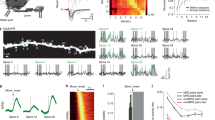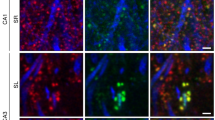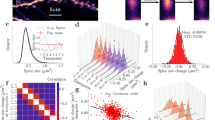Abstract
Functional circuits in the adult neocortex adjust to novel sensory experience, but the underlying synaptic mechanisms remain unknown1. Growth and retraction of dendritic spines with synapse formation and elimination could change brain circuits2,3,4,5,6,7. In the apical tufts of layer 5B (L5B) pyramidal neurons in the mouse barrel cortex, a subset of dendritic spines appear and disappear over days, whereas most spines are persistent for months4,5,6,8,9. Under baseline conditions, new spines are mostly transient and rarely survive for more than a week. Transient spines tend to be small4,5,9, whereas persistent spines are usually large4,5,6,8,9. Because most excitatory synapses in the cortex occur on spines, and because synapse size10 and the number of α-amino-3-hydroxy-5-methyl-4-isoxazole propionic acid (AMPA) receptors11,12,13 are proportional to spine volume, the excitation of pyramidal neurons is probably driven through synapses on persistent spines. Here we test whether the generation and loss of persistent spines are enhanced by novel sensory experience. We repeatedly imaged dendritic spines for one month after trimming alternate whiskers, a paradigm that induces adaptive functional changes in neocortical circuits14,15. Whisker trimming stabilized new spines and destabilized previously persistent spines. New-persistent spines always formed synapses. They were preferentially added on L5B neurons with complex apical tufts rather than simple tufts. Our data indicate that novel sensory experience drives the stabilization of new spines on subclasses of cortical neurons. These synaptic changes probably underlie experience-dependent remodelling of specific neocortical circuits.
This is a preview of subscription content, access via your institution
Access options
Subscribe to this journal
Receive 51 print issues and online access
$199.00 per year
only $3.90 per issue
Buy this article
- Purchase on SpringerLink
- Instant access to full article PDF
Prices may be subject to local taxes which are calculated during checkout



Similar content being viewed by others
References
Buonomano, D. V. & Merzenich, M. M. Cortical plasticity: from synapses to maps. Annu. Rev. Neurosci. 21, 149–186 (1998)
Bailey, C. H. & Kandel, E. R. Structural changes accompanying memory formation. Annu. Rev. Physiol. 55, 397–426 (1993)
Knott, G. W., Quairiaux, C., Genoud, C. & Welker, E. Formation of dendritic spines with GABAergic synapses induced by whisker stimulation in adult mice. Neuron 34, 265–273 (2002)
Trachtenberg, J. T. et al. Long-term in vivo imaging of experience-dependent synaptic plasticity in adult cortex. Nature 420, 788–794 (2002)
Holtmaat, A. J. et al. Transient and persistent dendritic spines in the neocortex in vivo. Neuron 45, 279–291 (2005)
Zuo, Y., Yang, G., Kwon, E. & Gan, W. B. Long-term sensory deprivation prevents dendritic spine loss in primary somatosensory cortex. Nature 436, 261–265 (2005)
De Paola, V. et al. Cell type-specific structural plasticity of axonal branches and boutons in the adult neocortex. Neuron 49, 861–875 (2006)
Grutzendler, J., Kasthuri, N. & Gan, W. B. Long-term dendritic spine stability in the adult cortex. Nature 420, 812–816 (2002)
Majewska, A. K., Newton, J. R. & Sur, M. Remodeling of synaptic structure in sensory cortical areas in vivo. J. Neurosci. 26, 3021–3029 (2006)
Harris, K. M. & Stevens, J. K. Dendritic spines of CA1 pyramidal cells in the rat hippocampus: serial electron microscopy with reference to their biophysical characterisitcs. J. Neurosci. 9, 2982–2997 (1989)
Nusser, Z. et al. Cell type and pathway dependence of synaptic AMPA receptor number and variability in the hippocampus. Neuron 21, 545–559 (1998)
Takumi, Y., Ramirez-Leon, V., Laake, P., Rinvik, E. & Ottersen, O. P. Different modes of expression of AMPA and NMDA receptors in hippocampal synapses. Nature Neurosci. 2, 618–624 (1999)
Matsuzaki, M. et al. Dendritic spine geometry is critical for AMPA receptor expression in hippocampal CA1 pyramidal neurons. Nature Neurosci. 4, 1086–1092 (2001)
Diamond, M. E., Huang, W. & Ebner, F. F. Laminar comparison of somatosensory cortical plasticity. Science 265, 1885–1888 (1994)
Fox, K. Anatomical pathways and molecular mechanisms for plasticity in the barrel cortex. Neuroscience 111, 799–814 (2002)
Denk, W., Strickler, J. H. & Webb, W. W. Two-photon laser scanning microscopy. Science 248, 73–76 (1990)
Denk, W. & Svoboda, K. Photon upmanship: why multiphoton imaging is more than a gimmick. Neuron 18, 351–357 (1997)
Feng, G. et al. Imaging neuronal subsets in transgenic mice expressing multiple spectral variants of GFP. Neuron 28, 41–51 (2000)
Glazewski, S. & Fox, K. Time course of experience-dependent synaptic potentiation and depression in barrel cortex of adolescent rats. J. Neurophysiol. 75, 1714–1729 (1996)
Shepherd, G. M., Pologruto, T. A. & Svoboda, K. Circuit analysis of experience-dependent plasticity in the developing rat barrel cortex. Neuron 38, 277–289 (2003)
Lu, S. M. & Lin, R. C. S. Thalamic afferents of the rat barrel cortex: a light- and electron-microscopic study using Phaseolus vulgaris leucoagglutinin as an anterograde tracer. Somatosens. Mot. Res. 10, 1–16 (1993)
Toni, N., Buchs, P. A., Nikonenko, I., Bron, C. R. & Muller, D. LTP promotes formation of multiple spine synapses between a single axon terminal and a dendrite. Nature 402, 421–425 (1999)
Yuste, R. & Bonhoeffer, T. Genesis of dendritic spines: insights from ultrastructural and imaging studies. Nature Rev. Neurosci. 5, 24–34 (2004)
Jontes, J. D. & Smith, S. J. Filopodia, spines, and the generation of synaptic diversity. Neuron 27, 11–14 (2000)
Chagnac-Amitai, Y., Luhmann, H. J. & Prince, D. A. Burst generating and regular spiking layer 5 pyramidal neurons of rat neocortex have different morphological features. J. Comp. Neurol. 296, 598–613 (1990)
Larkman, A. & Mason, A. Correlations between morphology and electrophysiology of pyramidal neurons in slices of rat visual cortex. I. Establishment of cell classes. J. Neurosci. 10, 1407–1414 (1990)
Kasper, E. M., Larkman, A. U., Lubke, J. & Blakemore, C. Pyramidal neurons in layer 5 of the rat visual cortex. I. Correlation among cell morphology, intrinsic electrophysiological properties, and axon targets. J. Comp. Neurol. 339, 459–474 (1994)
Tsiola, A., Hamzei-Sichani, F., Peterlin, Z. & Yuste, R. Quantitative morphologic classification of layer 5 neurons from mouse primary visual cortex. J. Comp. Neurol. 461, 415–428 (2003)
Pologruto, T. A., Sabatini, B. L. & Svoboda, K. ScanImage: Flexible software for operating laser-scanning microscopes. Biomed. Eng. Online 2, 13 (2003)
Fiala, J. C., Feinberg, M., Popov, V. & Harris, K. M. Synaptogenesis via dendritic filopodia in developing hippocampal area CA1. J. Neurosci. 18, 8900–8911 (1998)
Acknowledgements
We thank L. Petreanu for suggesting the comparison of cell types; V. DePaola, B. Burbach and C. Musetti for help with experiments; K. Masback for data analysis; T. O'Connor for writing the spine analysis software; and V. DePaola, G. Shepherd, J. Trachtenberg and K. Zito for comments on the manuscript. This work was supported by the Howard Hughes Medical Institute, the NIH and the Swiss National Science Foundation (G.W.K, E.W.).Author Contributions A.H. and L.W. contributed equally to this work. A.H. and L.W. performed the imaging experiments. K.S. built the custom microscope. G.W.K. performed the ssEM reconstructions with help from A.H. and L.W. G.W.K., A.H. and L.W. performed the cell reconstructions. A.H., L.W. and K.S. analysed the data and wrote the paper. All authors discussed the results and commented on the manuscript.
Author information
Authors and Affiliations
Corresponding author
Ethics declarations
Competing interests
Reprints and permissions information is available at npg.nature.com/reprintsandpermissions. The authors declare no competing financial interests.
Supplementary information
Supplementary Notes
This file contains Supplementary Notes 1 and 2, Supplementary Discussion 1 and 2, Supplementary Methods and Supplementary References (PDF 37 kb)
Supplementary Figure 1
Survival function (PDF 91 kb)
Supplementary Figure 2
Location-dependent growth of persistent spines. (PDF 196 kb)
Supplementary Figure 3
New spine growth. (PDF 100 kb)
Supplementary Figure 4
Examples of complex-tuft and simple-tuft cells and correlations. (PDF 126 kb)
Rights and permissions
About this article
Cite this article
Holtmaat, A., Wilbrecht, L., Knott, G. et al. Experience-dependent and cell-type-specific spine growth in the neocortex. Nature 441, 979–983 (2006). https://doi.org/10.1038/nature04783
Received:
Accepted:
Issue Date:
DOI: https://doi.org/10.1038/nature04783
This article is cited by
-
Repeated diagnostic ultrasound exposure modifies the structural properties of CA1 dendrites and alters the hippocampal transcriptome
Scientific Reports (2024)
-
Randomly fluctuating neural connections may implement a consolidation mechanism that explains classic memory laws
Scientific Reports (2022)
-
A subpopulation of cortical VIP-expressing interneurons with highly dynamic spines
Communications Biology (2022)
-
Structure and function differences in the prelimbic cortex to basolateral amygdala circuit mediate trait vulnerability in a novel model of acute social defeat stress in male mice
Neuropsychopharmacology (2022)
-
SIRT1 deficiency increases O-GlcNAcylation of tau, mediating synaptic tauopathy
Molecular Psychiatry (2022)



